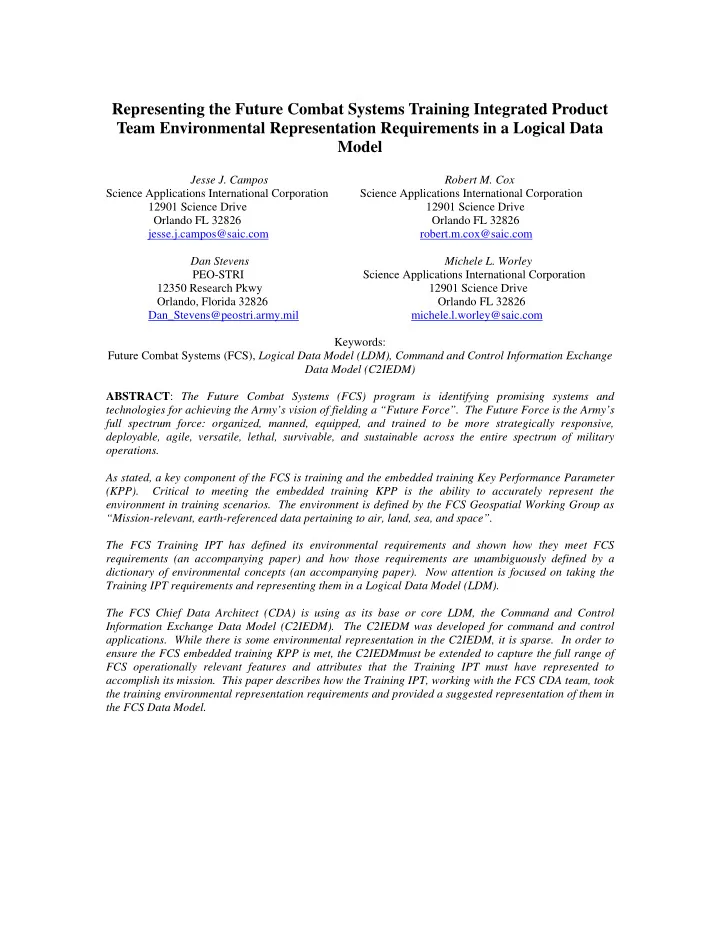

Representing the Future Combat Systems Training Integrated Product Team Environmental Representation Requirements in a Logical Data Model Jesse J. Campos Robert M. Cox Science Applications International Corporation Science Applications International Corporation 12901 Science Drive 12901 Science Drive Orlando FL 32826 Orlando FL 32826 jesse.j.campos@saic.com robert.m.cox@saic.com Dan Stevens Michele L. Worley PEO-STRI Science Applications International Corporation 12350 Research Pkwy 12901 Science Drive Orlando, Florida 32826 Orlando FL 32826 Dan_Stevens@peostri.army.mil michele.l.worley@saic.com Keywords: Future Combat Systems (FCS), Logical Data Model (LDM), Command and Control Information Exchange Data Model (C2IEDM) ABSTRACT : The Future Combat Systems (FCS) program is identifying promising systems and technologies for achieving the Army’s vision of fielding a “Future Force”. The Future Force is the Army’s full spectrum force: organized, manned, equipped, and trained to be more strategically responsive, deployable, agile, versatile, lethal, survivable, and sustainable across the entire spectrum of military operations. As stated, a key component of the FCS is training and the embedded training Key Performance Parameter (KPP). Critical to meeting the embedded training KPP is the ability to accurately represent the environment in training scenarios. The environment is defined by the FCS Geospatial Working Group as “Mission-relevant, earth-referenced data pertaining to air, land, sea, and space”. The FCS Training IPT has defined its environmental requirements and shown how they meet FCS requirements (an accompanying paper) and how those requirements are unambiguously defined by a dictionary of environmental concepts (an accompanying paper). Now attention is focused on taking the Training IPT requirements and representing them in a Logical Data Model (LDM). The FCS Chief Data Architect (CDA) is using as its base or core LDM, the Command and Control Information Exchange Data Model (C2IEDM). The C2IEDM was developed for command and control applications. While there is some environmental representation in the C2IEDM, it is sparse. In order to ensure the FCS embedded training KPP is met, the C2IEDMmust be extended to capture the full range of FCS operationally relevant features and attributes that the Training IPT must have represented to accomplish its mission. This paper describes how the Training IPT, working with the FCS CDA team, took the training environmental representation requirements and provided a suggested representation of them in the FCS Data Model.
. In order to help meet the requirements and the need for the total environment, the FCS Training 1. Introduction IPT developed the Training Common Component (TCC) program. One of the seven The Future Combat Systems (FCS) program is (7) TCCs is called Environmental Representation identifying the promising systems and (ER). The ER has the task to identify the technologies for achieving the Army's vision of environmental requirements needed to create an fielding a "Future Force.” The Future Force is environmental representation of the complete the Army's full spectrum force; organized, environment, not just the terrain for the Training manned, equipped and trained to be more IPT. strategically responsive, deployable, agile, versatile, lethal, survivable, and sustainable 2. Background across the entire spectrum of military operations. FCS tactics will enable the Future Force to see 2.1. FCS Data Architecture Team first, understand first, act first and finish decisively as the means to tactical success. This program will be a multi-functional, multi- The FCS program has identified a team call the mission re-configurable system of systems to Data Architecture Team (DAT) that is maximize joint inter-operability, strategic responsible for developing the integrated FCS transportability and commonality of mission Data Model. That data model is called the Unit roles including direct and indirect fire, of Action (UA) Information Model (IM). reconnaissance, troop transport, counter mobility, non-lethal and C2 on the move. The The UA IM will be developed and delivered to goal of this effort is to develop a network centric software development in both logical and advanced force structure, quantify its benefits physical forms. It is being developed using the and identify materiel solutions and technologies Unified Modeling Language (UML) and within the context of that force. To achieve this supporting IBM Rational Rose tool. To get to a goal of interoperability and commonality across normalized common view of the data model, the the FCS, there is a requirement for a common DAT is taking a two (2) phased approach called environmental representation. a Core-View Development (CDV). CDV involves the identification and integration of For many years, the U.S. Army has focused its “core” data definitions and relationships and environment efforts on the terrain. This common development common data views needed by environment also means that the operators and system applications. It provides a means for trainers will be using the same environmental leveraging legacy and planned enterprise representation. reference data models to support the development system unique data representations. As mentioned above, the FCS identified the It supports the three (3) tiered data management environment as an area that spans all domains architecture necessary for information sharing in and they must be defined. To that end the FCS a network-centric environment: Data Store, Geospatial Battlespace Environment (GBE) Mediation, and Application layers. Working Group (WG) has the charter to define the problem space and in concert with the FCS The basis for the FCS UA IM is the C2IEDM. IPTs identify the requirements that must be met. The Command and Control Information The FCS GBE WG under the auspices of the Exchange Data Models (C2IEDM) is the Army’s FCS Functional Decomposition Functional planned Command and Control (C2) data model Allocation (FD/FA) effort developed the for network centric warfare. From the core data definition of “geospatial” that would apply to the definitions, entities, and relationships, the CVD FCS and meet the FCS requirement of the total approach provides for the development of environment. That definition is: common and system unique data “views”. These views can then be developed by FCS architecture “Mission-relevant, earth-referenced data and software development teams to define the pertaining to air, land, sea, and space.” data views needed by FCS applications. The result is a standards compliant data architecture.
Recommend
More recommend